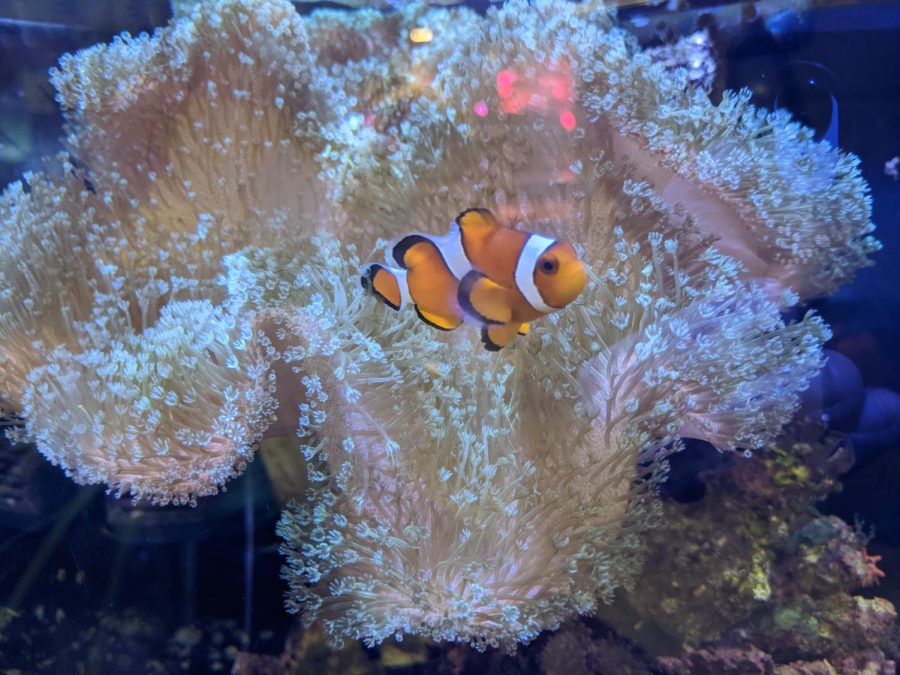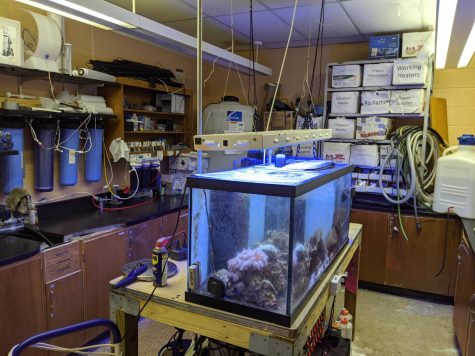Hidden in the depths: North Penn’s own coral reef
The clownfish in C016, bonded to an anemone as its home.
Many of us stranded in suburbia find coral reefs to be enchanting, almost mystical labyrinths of underwater jungles— but all the same unreachable for land-lubbers like ourselves. However, nestled in the center of the first floor C-pod, students and the science department have teamed up in the school coral lab to bring a slice of the salt life to North Penn.
According to Mr. Shane Misuro, the department’s marine science teacher, North Penn has been a pioneer for high school sciences, kick starting an in-house coral lab before any other high schools to this day.
“We are, as far as I’m aware, the only high school in the United States to have a coral lab. Probably about 10 years ago at this time, we decided we should petition for actual lab space… and so it was furnished, wired and essentially established for club-oriented activity,” Misuro stated.
As the project ballooned into something far larger than simply club commitment, Misuro and the botany teacher Mr. Daniel Krueger had to go above and beyond to maintain operations below deck.
“Mr. Krueger or I both work here all throughout the year, during every vacation, every summer, and we switch off weeks where we call each other in… We’ve built everything in this room over the years purposely, none of this could be bought assembled. Especially when activities constantly shift for student needs, we need to rearrange installations to account for that,” Misuro said.
Currently, the lab is housing fish from the 2021 C-pod display, arranged as a combined 160-gallon saltwater tank, and a breeding station to feed the sustained coral. Open bags of nutrients and testing solutions populate cabinets hung above the counter tops, evidence of daily duties. Numerous empty tanks that line the upper shelves pay homage to projects long since disassembled.
Despite its liminal appearance, Misuro plumes himself over the years of accomplishments and connections the lab has offered.
“The main thing we’ve tried to do here is obviously coral, physically growing it, ‘fragging,’ or sectioning it, then propagating it. We build out these big mother colonies and spend parts of the year cutting up coral and sticking them to little pucks for sale,” Misuro continued. “You used to be able to go into an old store called Reef to Rift where there was a North Penn coral tank that we supplied, and anything you bought would directly fund us. That was a pretty cool little connection offered to us by virtue of being a school with this kind opportunity.”
Individual student-led projects are also a major point of interest in the lab, which have come with equally major learning moments.
“There was a kid, one who was designing a tank for jellyfish, to breed them too. It was created by Marine Botanical, but ended up being the world’s longest project, taking halfway through the year with no animals in sight… We had no incentive to let him take any longer, because we had little expectation any jellyfish would go into the tank. Scope and time are big things we try to guide so it doesn’t end up like that,” Misuro recalled.
Misuro continued to grant that the lab offers a unique margin of error for such an applicable and authentic environment.
“On the other hand our independent study last year, Sam, lit fire to our 125-gallon tank— kind of. We didn’t kill any fish, but it was the closest we’ve ever been. That’s a fun error because, you know, it didn’t actually happen. But, you also learn from that by having a program where you can do that and it doesn’t stop everything, and we can adjust for it and learn, which is really invaluable,” Misuro elaborated.
One of the biggest draws boasted by the lab has undoubtedly been the sheer volume and gamut of student involvement the lab offers.
Responsibilities of managing the tanks during the year are split between Marine and Botanical Society members, independent study students, and work studies that spend the most time shadowing. While they all vary in objective, Misuro is sure they all have one thing in common.
“Students may or may not enjoy marine science as much coming out of it as they thought going in, because this is the reality of a lab… The big takeaway that everyone says, though, is that they physically worked with their hands. They came into the lab, tested, worked upon, and really learned so much more than completing a lesson or a worksheet,” Misuro explained.
If getting involved in the coral lab sounds like something you could dive into, or you would like to keep Marine Botanical Society “growing and going,” speak with Mr. Misuro in E118 or Mr. Krueger in C016.



